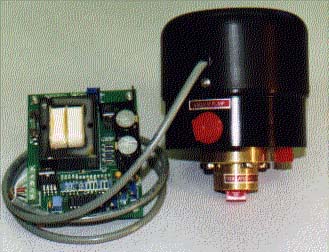 The Model 470 Electronic Vacuum Regulator is designed to accept a users analog control signal generated from their electronic system or potentiometer to adjust the setpoint of the vacuum regulator. Two options of pressure sensors are available which allows a user the choice of either absolute pressure reference sensing or differential pressure reference sensing . The Model 470 Electronic Vacuum Regulator is designed to accept a users analog control signal generated from their electronic system or potentiometer to adjust the setpoint of the vacuum regulator. Two options of pressure sensors are available which allows a user the choice of either absolute pressure reference sensing or differential pressure reference sensing .
Specifications
Flow Passage at full flow:
0.480 inch diameter
Cv = 3.4
Adjustability Range:
From .015 inch Hg below atmospheric pressure to near 0 pressure absolute*
Hysteresis:
Approximately .004 inch
Hg (0.1mm Hg)
Flow Sensitivity :
Flow variation from 0 to 350 liters per minute results in setpoint shift of less than 0.1 inch Hg.
Weight:
Regulator: 3.2 pounds
Control Board: 1 pound
Flow Ports:
1/2 inch NPT (Female National Pipe Thread)
Applications
The Model 470-002 is ideal for vacuum regulator applications requiring more vacuum flow than the capacity of the Model 487 alone. For finer vacuum setting resolution a Model 484 can be used with the 470-002 vacuum flow amplifier. However, a small atmospheric leak is required if used with the Model 484 regulator to enable to lower vacuum settings since the 484 is not self-relieving. Vacuum Flow rates of up to 12 scfm are possible with only a 1 psi pressure drop across the device. Flow rates in excess of 12 scfm will result in more pressure drop across the regulator. The flow booster is a non-relieving design, which means vacuum down stream must be vented by introducing an air leak (if no leakage is already present) in order to enable reductions in the vacuum setting.
Absolute Pressure Reference
An absolute pressure reference will sense vacuum compared to near zero pressure or a perfect vacuum. This operation is similar to that of the Model 329 which also references absolute pressure. Absolute pressure reference is commonly used in applications such as calibration, altitude simulation, and a variety of low absolute pressure regulation situations.
Differential Pressure Reference
The use of a differential pressure reference will allow an application to sense pressure relative to the ambient atmospheric pressure or another pressure of interest. Differential pressure sensing will eliminate the small pressure variation which results when an application should ideally reference the atmospheric pressure, but does not. In such cases the desired pressure setting will vary in the same amount as the atmospheric pressure which changes over time. |




